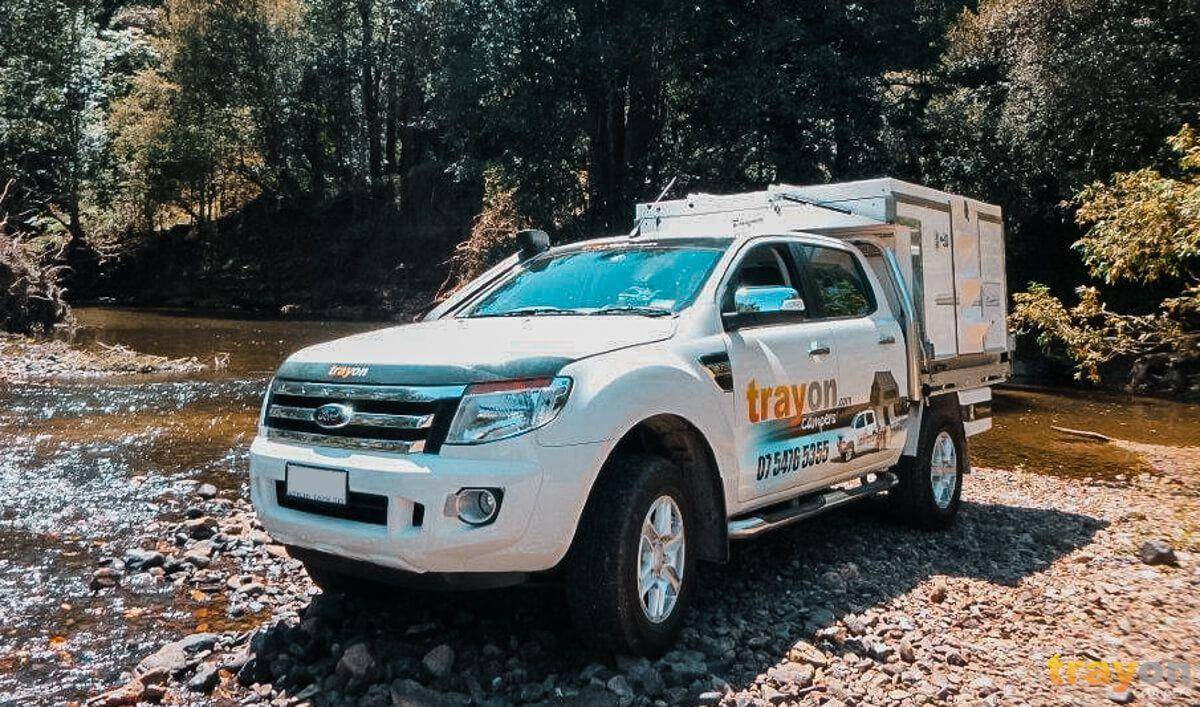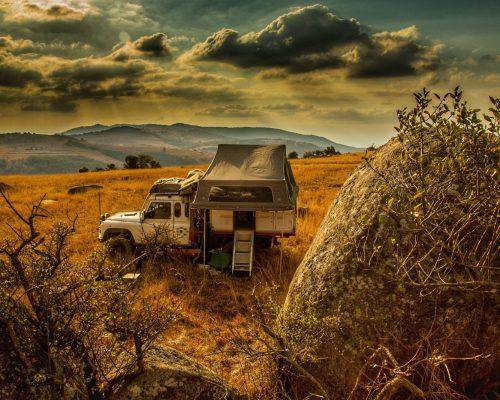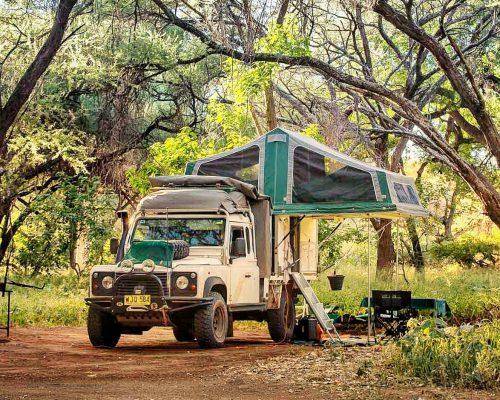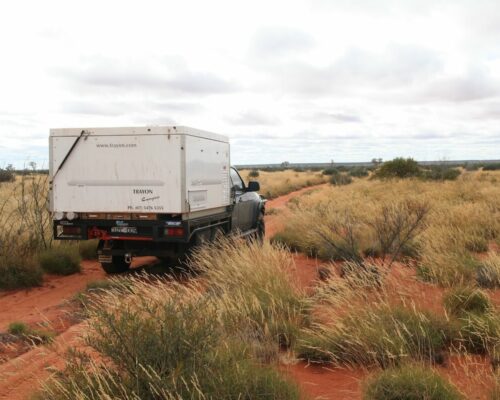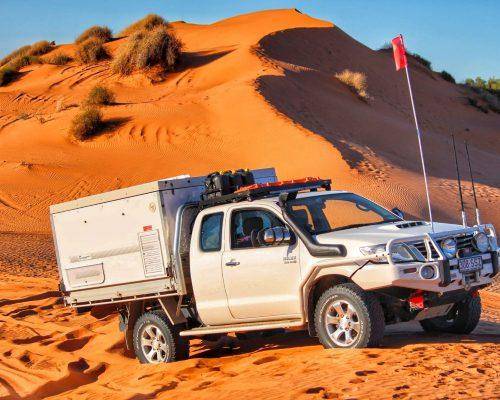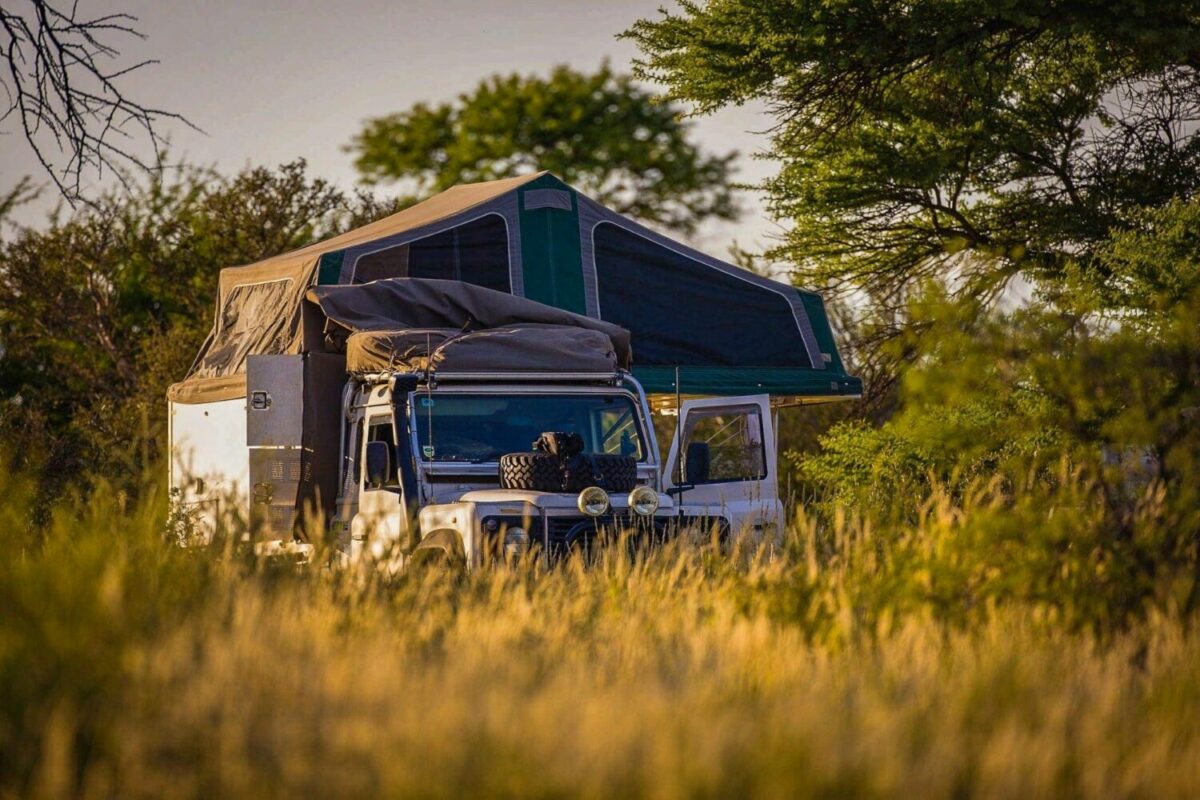There’s a lot of hype surrounding the Ford Ranger at the moment. In 2017, it topped the 4×4 sales charts in Australia, a position held by Toyota for decades! The trend doesn’t look like it’s slowing down either.
The 2018 Ford Ranger Ute lineup is continuing its surge into the top echelon of Australia’s favourite utility vehicles.
It’s now considered one of the best options for touring and exploring the Australian Outback, while also providing comfort and manoeuvrability in the urban environment. It’s received particularly high praise in it’s off road performance, and in 2016 was crowned the best off road 4×4 by Carsguide.
Ford and Trayon
We’ve used a Ford Ranger off road ute (PXI XLT model) as a demonstration vehicle for Trayon slide on campers for years now, and we’ve also been thoroughly impressed with its all round performance. But we understand that, with the huge variety of similar style utes out there today, picking one can be a pretty tough decision!
For what it’s worth, at the present (early 2018), the Ford Ranger is our top pick for mid range four wheel drives to carry a Trayon slide on camper. So it’s time we provided our two cents to help you work out if its the 4×4 ute for you!
Trayon’s Official Ford Ranger Ute Review
We’ve been in the off road industry for 25 years now, and we know exactly what traits make a vehicle ready for tough off road situations. We use this knowledge to provide honest, practical advice about the latest models in the Ford Ranger Ute series.
In this article, we focus on the Ranger’s suitability for off road exploration, towing capacity, performance, payload capacity, its suitability to carry the constant load of a Trayon slide on camper, and how it stacks up as a candidate for the Australian touring dream!
We also discuss its evolution, the standard features you get with today’s Ranger Ute, and general performance compared to some of its main rivals.
By the end, you should be quite a bit closer to deciding whether you want to pilot one on your next touring adventure!
The Birth of The Ford Ranger Ute
The Ford Ranger has been a looong time in the making. There’s even rumours that Ford Australia invented the first ever official ute!
While other evidence suggests it was Oldsmobile, Dodge, or Ford USA in the early 1900s, Ford Australia definitely made the first ute on Australian soil in the 1930s. The ute was dubbed by Henry Ford himself as the ‘Kangaroo Chaser”!
Fast forward almost 90 years, and you have today’s Ford Ranger Ute, predecessor to the Ford Courier. Even though it looks and drives a little different from the Kangaroo Chaser, its made for the much the same reason; hard yakka, work or play.
2018 Ford Ranger Ute Evolution
The latest version of the Ford Ranger stems back to 2011, when it underwent a drastic revamp.
The most significant upgrade was the introduction of Ford’s cornerstone 3.2L five cylinder turbo-diesel engine. We think the engine upgrade had a lot to do with the Ranger’s surge to the top.
It also had a running gear makeover, with an updated chassis and suspension. On the outside, it went from straight and boxy to the broader, tougher look that we recognize today.
Since 2012
It then went from the PK series to the PX, where it further increased in size, and really started to bridge the modern gap between the mid range 4WD category and the heavy duty class (e.g. the 79 Series Landcruiser or new Mercedes G Class Ute).
The gap is still there, but it’s shrinking!
The PX series (both mach 1 and more recently the mach 2) was based on the Melbourne designed and Australian manufactured T6 platform, and is used in Ford Ranger variations around the entire world (it’s actually the only ute to use the same platform across global vehicle production!).
Recent Success
In early 2016, the Ford Ranger mounted its charge against the closest rivals.
Later that year, the Ranger along with the Toyota Hilux, made history when they topped monthly charts in Australian new vehicle sales, making it the first time ever that a ute took the crown!
Ford and Toyota have locked their utility horns ever since, with the Ranger pulling ahead in 2017 4×4 sales (it was actually the highest selling 4×4 in the country!). Although Toyota had more ute sales overall thanks to its stranglehold on the fleet vehicle market.
Note: The Mazda BT-50 is a similar vehicle, and is actually a re-badged Ford design. That doesn’t make it the same however, and we will point out why throughout the article.
2018 Availability
The Ford Ranger PX will stay largely unchanged from 2017, except for a few minor updates. It’s available in single cab, super cab, and double cab 4×4 touring setups, and continues on with the XL, XL Plus, XLS, XLT and Wildtrak variations
Ford Ranger Ute Interior Features
The first thing you notice on the inside of a Ford Ranger is the space.
Internally, it’s bigger than a Hilux, and packs in a huge range of features. The dash is large and pronounced, smoothly stretching from one side to the other with a nice sized console set in the middle.
The console holds the new SINC3 high resolution eight inch touch screen, a standard feature in the XLT and Wildtrak, and providing Apple carplay and android voice command abilities. The previous SINC2 system lacked the intuitiveness of some of the Ford Ranger’s competitors, but the SINC3 should address those issues.
Seats are very supportive, highly adjustable, and heated in the higher end models (e.g. the Wildtrak). The steering wheel has controls for entertainment and phone play, while climate control is on the centre console.
Everywhere you look, the Ford Ranger’s interior provides convenience, including sunglass holders, bottle holders, 2x12V sockets, 2xUSB ports and a 230V socket to turn the vehicle into a mobile office! Even the back seats have access to these power options!
Everything is nice to touch, and provides great comfort for long trips. The Wildtrack also has a hand stitched leather interior, but this isn’t necessarily a good thing for exploring the Outback, where dust and debris will be a common internal feature, potentially degrading the leather quality!
A Exterior Features of a Ranger
On the outside, the Ford Ranger has broad shoulders and a tough (but stylish) look. The exterior kit out varies for each different model. Eighteen inch alloy rims are standard, with options for all terrain or off road tyres.
Pick-up versions come with tub liners, different kinds of roll bars, and rear bumpers.
Ultimately it’s exterior appeal will vary for each individual.
Ford Ranger Engine Specs
Under the hood, the Ford Ranger comes in the following options:
- 2.2L 4 cylinder Turbo Diesel
- 3.2L 5 cylinder Turbo Diesel
| Spec | 2.2L TDCi | 3.2L TDCi |
| Kilowatts | 118 | 147 |
| Nm@rpm | 385 @ 1600 – 2500) | 470 @ 1750 – 2500 |
The 3.2L in particular has a long running track record for reliability, and is able to clock up big kilometres with a good engine servicing regime. The 2018 versions have undergone tweaks to further improve performance and reduce sound, vibration and harshness.
Both the 2.2L four cylinder and 3.2L five cylinder are available in six speed manual or automatic (although not all vehicle configurations come with this choice).
Ford Ranger Dimensions
The Ford Ranger’s wheelbase is 3220 mm in length (from midpoint of the front wheel to midpoint of the rear wheel) which, along with the Mazda BT-50, makes it the longest of the current mid range 4×4 dual cabs (and is an advantage when towing).
Its total length is between 5113 mm and 5426 mm, depending on which specific model, and what kind of Ford bumpers are fitted. They’re 1860 mm in width (excluding mirrors) and 1800mm to 1848 mm in height, depending again on which configuration.
Ford Ranger Ute Driving Accessories
The Ranger also has a huge suite of electronic driving aids (some standard and some part of tech upgrade packages) which drastically improve driving performance. These include:
- Navigation plus traffic management channel
- Electric power assisted steering (provides greater manoeuvrability and easier parking at slow speeds, compared to the previous hydraulic system, which the BT-50 still has)
- Cable shift manual transmission
- Auto stop start on manual ranger models
- Reverse camera
- Adaptive load control
- Trailer sway mitigation
- Projector headlamps
What Safety Equipment and Ratings Come with a Ranger
It has six airbags, the maximum 5-star ANCAP rating, and a huge list of electronic safety features available, such as:
- Rain sensing wipers
- Driver impairment monitor
- Emergency brake assistance in this ford ranger
- Dynamic stability control and rollover mitigation (standard in FX4, and available in a tech package for others)
- Emergency 000 dialling in an accident situation (it provides emergency services with GPS location and opens a hands free communication line through the driver’s phone!).
Further tech safety options for the FX4 and XLT models (but standard in the Wildtrack) include:
- Forward collision alert
- Lane keeping aid and departure alerts
- Auto headlights
- Adaptive cruise control
- Proximity alerts
Many of these safety features and options aren’t provided by its competitors, let alone many other types of high end vehicles!
Ford Ranger Ute Driving Performance
By all accounts, and our own experience, the Ford Ranger drives great.
This is one of the areas it pulls ahead of its close cousin, the Mazda BT-50. Without taking anything away from the Mazda which has good reviews as well, the Ford Ranger is a more comfortable ride, thanks to a smoother gearbox and some subtle suspension tweaks the Mazda missed out on.
Off road utes are known to have very stiff and uncomfortable 4WD suspension when empty, but the Ranger’s suspension is quite comfortable even without a load.
On the downside, there is a little bit of turbo lag (which is common among many turbo diesel vehicles), and slight body roll when cornering at speed.
All the sensors, safety features and alerts can also be a bit frustrating at times and may have to be switched off for certain activities (for example when driving in the bush, proximity alerts on the Wildtrack are triggered by every twig). But that’s the worst of it.
When on the open road, it provides a firm and confident feel, which is hardly affected by loads and towing.
Ford Ranger Weight and Payload Capacity
The Ford Ranger has a gross vehicle mass (GVM), set by Ford, of 3.2 Tonne (which is one of the best of any 4×4 ute in this vehicle class). Kerb weight (i.e the actual weight of the vehicle) varies quite a bit depending on which model you’re looking at. For example, the single cab 4×4 ute has a kerb weight of 1.86 Tonne, while the Wildtrak Double Cab ute is 2.25 Tonne.
This results in variable payload capacity as well (the available payload is simply calculated by removing the vehicles kerb weight from its total legal allowable weight, aka GVM). For example, the 4×4 XL Single Cab ute has a payload capacity of 1.34 Tonne, the 4×4 XL Super Cab ute is 1.27 Tonne, and the Wildtrak Double Cab ute is 950 kilograms.Payload goes down as the kerb weight of the vehicle goes up.
The gross combined mass of all Ford Ranger models is 6 Tonne (that’s the total legal weight of the loaded vehicle plus a loaded trailer).
Ford Ranger Towing Performance
The Ford Ranger has a towing capacity of 3.5 Tonnes.
Carsguide.com lists it in the top 10 vehicles in Australia for towing, alongside rivals such as Toyota Landcruisers and the Volkswagen Amarok.
Driving a Ranger while towing is very smooth and easy. The engine has an improved torque curve, providing nice low down power to pull a trailer through most terrain. The diesel engine braking also helps to maintain a steady pace downhill. It even has trailer sway mitigation features.
Ford Ranger Fuel Efficiency
The Ford Ranger has a few interesting perks to help improve fuel consumption.
The first is a gear shift indicator lamp, to tell you when is the most efficient time to change gear (while manual driving), thus optimizing fuel efficiency. The second aid is the electronic power assisted steering, which means no power steering pump, improving fuel efficiency by approximately three per cent.
Taking all this into account, the Ford Ranger will drink around 8.3 – 9 Litres per 100 kilometres (excluding when towing). When carrying heavy loads or towing, consumption will rise to between 10 – 15 Litres per 100 kilometres, depending on weight, terrain and speed.
Hard off road work will increase that further. Which provides a good segue off the bitumen.
Ford Ranger Off Road Capabilities
The Ford Ranger is well known to be a great off road performer, and very well suited for Australian off road work like beaches, dirt, deserts, rocky creek beds and the rest. It is very capable straight of the factory floor!
It has a ground clearance of 237 mm, a maximum approach angle of 28 degrees and departure angle of 25 degrees. Its improved torque curve, available low in the rev range, pulls it through any soft terrain (with the right tyres and driving technique of course), and is particularly effective with an automatic gearbox (which avoids any loss of momentum in the soft stuff).
High range 4×4 gear ratio is a 1:1 ratio, and low range is 2.7:1. You can shift from 4×2 high to 4×4 high while on the fly, but need to be stationary to shift from 4×2 high to 4×4 low.
It has buttons to engage the rear diff lock (some 4×4 utes don’t even come with diff lock), as well as down and uphill assist features (which are most effective between 2 and 40 kph). The diff locker is particularly handy for soft, loose or steep terrain.
Our Ford Ranger demonstration vehicle will carry a Trayon slide on camper anywhere! It is tough, drives smoothly over rough terrain, and handles anything we throw at it. – Trayon Team
A tyre pressure monitoring system provides another advantage while travelling in the Outback, and it can be monitored and changed from the cab! An auxiliary battery also provides some extra charge for unexpected situations or power for Outback camping (note a second battery is only standard with an XL Plus model).
It has a wading limit of 800 mm, with stock air intakes and the alternator high up above that level. Solid recovery points are also standard. Spare tyres can be kept underneath the tray, behind the headboard, or on roof racks (if you have them installed, but more on that later).
The only area it gives ground to its arch rival the Hilux, is slightly less wheel articulation, and it does feel bigger and a bit less manoeuvrable in some situations. But overall, it definitely holds its own!
As with any modern vehicle, the plethora of electronic sensors and alerts can be counterproductive when tackling rough terrain. Even the 79 Series Landcruiser is ECU controlled now as well. The Ranger however, does have more electronic sensors and features than most (possibly to satisfy its huge range and variety of global customers).
These days, you can’t find a new vehicle that isn’t riddle with electronics. If you want one, you need to go pre-2005.
The Ford Ranger dealing With Electronics Off Road
If you want to take a Ford Ranger off roading in sand, mud, or any other slippery or boggy terrain, switch electronic stability off. If you don’t, when your wheels slip, it’ll think your losing control and divert power away from the slipping wheels, which can leave you up the creek without a paddle.
Also turn proximity sensors off if you’ve had them installed.
And finally, ask the dealer to switch on the alternators constant charge mode, to ensure all your batteries on board are fully charged up every time you travel somewhere.
To sum the Ford Ranger’s off road capability up, in the right hands the Ford Ranger is an extremely effective off road machine. Slide a Trayon camper on the tray, which come with a weight distribution designed to optimize off road performance, and you can’t go wrong!
That brings us to the next point; which tray and cab style to choose?
Ford Ranger Ute Configurations (Cab/Tray setup)
Ford Rangers come in tray back and pick-up tub options. Bear in mind though, that the Dual Cab XLS, XLT and Wildtrak versions only come in the pick up tub option, so you will need to get a tray fitted (we explain why a tray is the best Outback option soon).
The Single Cab should have a dealer option for a 2500 mm tray, which provides a heap of external storage space.
Super Cabs are best fitted with a 2100 or 2200 dealer tray, but be careful that the dealer does not try and give you a 1950 mm stubby tray, as is often the case. Super Cabs also provide the best cab space-to-tray space ratio. Just bear in mind that to open the back doors of a Super Cab, the front have to be slightly ajar.
The XL Dual Cab will come with an 1800 mm tray. Also, when buying a Dual Cab, make sure the headboard is no higher than 890 mm, so it doesn’t impede canopies, slide on campers or general loads which overhang the cab.
All Ford Ranger trays should be either 1830 or 1880 mm in width (measured from the outside of the tray).
Tray Installation Tips
If you can’t get the tray you want through your Ford dealer, contact us at Trayon and we can organise a Genuine Trayon Tray to be sent to and fitted at your Ford dealer before you drive it out the door. We replaced our Ford Ranger XLT Super Cab pick-up tub with a 2250 mm aluminium tray, and it provides a great bed for a Trayon.
We don’t make the Genuine Trayon Tray here at the factory. We have an arrangement with a large, high quality tray manufacturer to build trays which are perfectly suited to a Trayon camper. We can then have it sent anywhere in the country (i.e. to be fitted at your specific Ford/Vehicle Dealer).
If you’re planning to carry a Trayon camper with your Ford Ranger, a Genuine Trayon Tray will help avoid hassles like:
- Unsuitable tray length and width
- Too much headboard height
- Hook points in the way
- Bad tray space usage (some tray manufacturers place the headboard on top of the tray load surface which pushes the camper back further on the vehicle’s wheelbase unnecessarily).
- A lip on the tray’s back edge (some tray manufacturers include a pesky edge lip that rises up at the rear of the tray which can impede loads).
The Genuine Trayon Tray combats all of these issues.
Why is a Trayback More Practical than a Pick-up Tub?
A tub can severely limit what you can use the external storage space for.
A tub will also increase kerb weight, and reduce payload capacity. With an aluminium tray, you can carry more weight, and more awkward items that wouldn’t fit inside a tub. You can always fit sides to a tray to carry unstable loads like soil and green waste, but you can’t take the sides off a tub!
A tray will open up your canopy and camping options as well. When you store gear in a tray, rather than a tub, it provides the following advantages:
- There is more surface area to spread the gear out, thus lowering the centre of gravity.
- There is more space to distribute the load towards the centre of the vehicle (i.e. between the front and rear axles).
- It results in a more stable and safe off road experience.
For the same reason, canopies and slide on campers made to fit tray back utes, rather than pick up tubs, have better weight distribution, more space to fit in camping essentials, and provide an all round better off road rig.
For more information about which vehicle configuration is the best option for a Trayon camper (e.g. a single cab, extra cab/super cab, or dual cab) check out our recent article about 4×4 touring setups.
Touring Australia in a Ford Ranger Ute
The Ford Ranger makes an extremely good touring vehicle to explore the vast areas of Australia. With all its safety features, high comfort levels, and great payload and towing capacity, it’s pretty hard to beat (in terms of the mid range class of 4WD utes).
There is also meant to be the option in future Ford Rangers for a Wi-Fi hotspot, allowing you to connect your personal devices like phones, laptops and digital radios to the internet anywhere! No doubt this will have its limits in remote areas, unless it uses the iridium satellite network, but unlikely.
All Ford Rangers come standard with an 80 Litre fuel tank, which is pretty common across this range of vehicle, and probably warrants an aftermarket long range tank (or a few extra jerry cans) if long distance touring is your goal. Aftermarket suppliers and fitters like ARB, who have retailers Australia wide, are the best option.
Whatever your needs are, the Ford Ranger will be able to cater for all the touring and camping experiences you want!
In addition to all its touring advantages, we have a few extra tips which can help make the Ford Ranger a complete touring package:
- Get an Aluminium tray.
As we previously explained. It has big implications for storage flexibility, payload capacity, and off road performance. These days Aluminium trays are super strong and much lighter than steel, so they don’t eat into your payload any more than necessary.
- Add an On-board diagnostics (OBD) link to your road trip tool kit.
Everyone’s old school tool kit simply involved zip ties (for things which are moving but shouldn’t be), and WD40 (for things which aren’t moving, but should be).
An OBD link adds an extra option to check and solve issues with electronics and computer chip related alerts.
These days, electronics can actually limit driving capability if they sense a problem. If the vehicle senses an issue, it can limit driving capacity and actually prevent you from quickly limping to get mechanical help. The OBD link, synced to your phone, can read the code sent out by the vehicle CPU and tell you what’s wrong.
Then you can use the old duck tape or WD40 to try and fix the issue and limp to a mechanic if you have too!
- Make sure the Dealer switches the alternator from variable voltage to constant charge.
This is particularly important when touring in the Outback and carrying a slide on camper.
Without the alternator providing constant charge to your auxiliary batteries, you won’t have enough charge for your camping requirements, and it is also detrimental to the life of your batteries (which need to be kept fully charged, not semi charged, to maintain heath).
- Ask the Dealer to organise a GVM upgrade before it’s registered.
A GVM upgrade to the maximum of 3.5 Tonnes provides a number of benefits:
- You can simply carry more gear.
- You’re better prepared for unexpected circumstances while touring in the Outback (i.e. if you need to carry a mate’s gear as well). And
- You can better cope better with the greater forces encountered while off road driving (particularly while towing or carrying heavy loads).
By doing this through the dealer and before first registration, it is considered a second stage dealer upgrade. This saves you money and also ensures it is legally certified at the same time.
Check out our recent article about 4WD suspension for more information.
5. Consider Trayon’s TurnKey service to create the ultimate touring setup based around a new ford ranger
We have access to fleet sales, which means cheaper prices, and it forces car dealers to be more honest and thorough. We handle the end to end process, so all you do is order what you want in terms of dealer fitted options, aftermarket off-road accessories and camping equipment, then pick up a complete off road touring package a few months later!
For more information on what this service entails, check out our recent ‘TurnKey’ expedition vehicle article.
Ford Ranger Upgrades and Aftermarket Accessories
Ford Dealers will be able to fit a Ford Ranger Ute with a range of manufacturer accessories, including:
- Snorkel
- Side steps
- Sports bar
- Steel bull bar
- Bonnet protector
- Tow packs
- UHF radio
Aftermarket accessories are also many and varied, including bull bars, underbody protection, suspension upgrades, winches, and extra recovery points. We recommend ARB simply because they have so many locations and contacts Australia wide, which is perfect for touring and Outback driving.
One of the harder accessories to find can be aftermarket roof racks for Ford Ranger Super Cab models. We’ve found Tradesman Roof Racks in Melbourne make make a good fit (our demo vehicle has one on board).
Ford Ranger Warranty
Ford offer a range of road side assistance and warranty services, including:
- A 12 month Roadside Assistance package (the largest network of roadside assistance providers in Australia, through participating dealers only)
- A three year/100,000 km new car warranty. This covers you against any factory defects for the vehicle and Genuine Ford Accessories fitted before delivery.
- A five year warranty against perforation corrosion. If perforation corrosion occurs, they claim they will fix it for free (note though, that the corrosion will probably have to be pretty bad to get warranty support).
Ranger’s Off Road Warranty Implications
Driving a Ford Ranger off road will not impact warranty itself, but be aware that warranty only applies to factory defects (in materials or workmanship). So if you incur damage as a result of reckless driving, extreme weather, or any other accidental damage, you’re unlikely to find support through the vehicles warranty.
That’s where your insurance should come in! So, as with any vehicle purchase, make sure you find the right provider who can cover you for the type of driving you will be doing.
Ford Ranger Value for Money
The Ford Ranger 2018 price range in Australia sits between $38,000 (for a standard 4×4 Single Cab XL 2.2L Ranger), to $61,100 (for a 4×4 Special Edition XLT Dual Cab 3.2L Ranger).
Overall, we think the 2018 Ford Ranger Ute provides a great variety of touring options, and very good value for money.
Conclusions
There is no doubt the Ford Ranger sits in the top few mid range four wheel drive utes on the market today.
We would have no problem recommending a Ranger as wheels for a Trayon. While it is hard to split up that tight pack of vehicles at the top of the group, like the Ranger, Hilux and BT-50, there is one thing that is certain. The Ford Ranger will be giving its 4×4 rivals a run for their money for a long time to come!







